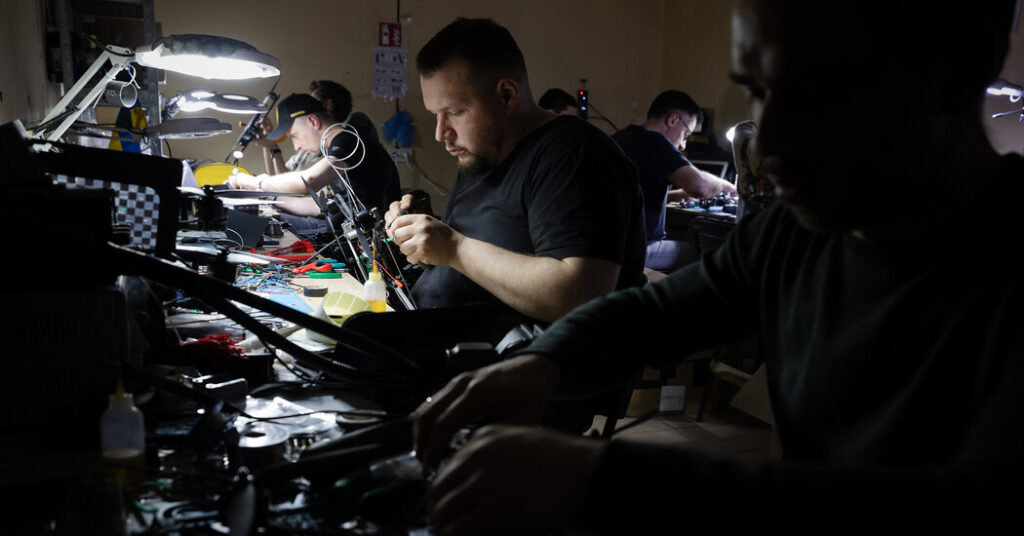Since President Trump took office vowing to pull back U.S. support for Ukraine, European leaders have worried that they would be unable to supply Ukraine with the weapons it needs.
So far, it looks like they were right.
The so-called coalition of the willing of European nations backing Ukraine has struggled to get materiel to its battlefields in the time since Mr. Trump made clear that Europe needed to shoulder more of the load for Ukraine’s security and its own.
That is one reason Ukraine’s Parliament overwhelmingly approved on Thursday a deal to give the United States a share of future revenue over natural resources, including minerals. While short of a security guarantee, it keeps open the possibility of continued shipments of American arms and other military assistance.
“This gives us hope,” said Yehor Chernev, the deputy chair of the Ukrainian parliament’s committee on national security, defense and intelligence.
In an interview shortly after the vote, Mr. Chernev said Ukrainian forces were running low on long-range missiles, artillery and, above all, ballistic air defense systems — the majority of which are manufactured in the United States, according to an analysis by the Kiel Institute for the World Economy.
By summer, military aid approved under the Biden administration will run out, and Mr. Trump appears reluctant to renew it.
“He told me that he needs more weapons, but he’s been saying that for three years,” Mr. Trump said after meeting with President Volodymyr Zelensky of Ukraine last month in Rome. (The Trump administration has allowed Ukraine to buy some small-dollar arms directly from American manufacturers, but not with U.S. government assistance.)
Allies in Europe have collectively given about half of the estimated $130 billion in military support provided to Ukraine since Russia invaded in 2022. The U.S. sent the rest.
While European leaders and investors appear willing to pump more money into weapons production, industry executives and experts predict it will take a decade to get assembly lines up to speed.
“Europe is trying to replace the assistance that we lost from the United States, but unfortunately, they don’t have the capacity to do this,” Mr. Chernev said. “It takes time between the decision and the real assistance.”
Though Mr. Trump has shown more alignment with Ukraine in recent days, including on Thursday threatening sanctions on Russia if it declined to agree to an extended cease-fire, his broader dismissiveness toward 80 years of U.S. protections for Europe has prompted allied nations there to rethink their security.
Allies fear that Mr. Trump will pull Russian deterrents, like U.S. troops and the American nuclear umbrella, out of Europe. Focusing on their own protection eats into what other European countries might have given to Ukraine.
“They are hitting the dual problem of having to rearm themselves and supply Ukraine, and industrial capacity isn’t big enough to do both,” said Matthew Savill, director of military sciences at the Royal United Services Institute, an analytical group affiliated with the British military.
He said Europe could backfill most of what the United States had provided in weapons to Ukraine, “in the medium- to long-term, if it has the will, and I’m not sure it has the will.”
And for now? “No. Not in the short term,” Mr. Savill said.
The weapons are not just a matter of life and death for Ukraine’s soldiers. Without adequate supplies, Ukraine could lose territory if it is forced to retreat. The cease-fire agreement that Mr. Trump is trying to broker would freeze the conflict in place. That would let Russia keep whatever ground it has captured in the meantime.
To be sure, the flow of weapons to Ukraine from Europe will continue even if American deliveries dry up. Germany recently sent Ukraine more than 60 mine-resistant armored vehicles, about 50,000 artillery rounds and air defense ammunition, including an IRIS-T interceptor that can take down cruise missiles. Some drones that Britain and Norway bought, announced last month as part of a $600 million security package, have since arrived in Ukraine. Estonia is sending 10,000 artillery shells.
But many of the European military assistance pledged last month at NATO headquarters amounted to commitments for producing or procuring weapons in the years to come, not immediately. Ukraine may need American weapons for some time.
Some of Europe’s financial support will help Ukraine’s defense industry. Mr. Chernev said that about 800 companies in Ukraine produce weapons. He estimated that Ukraine could produce $35 billion worth of weapons in coming years, but that it needed at least $14 billion invested from allies to get there. On Saturday, Denmark announced that it would send about $930 million in frozen Russian assets to support Ukraine’s defense industry on behalf of a European Union fund.
Already, Ukraine is churning out millions of drones each year, including cheap kamikazes to save its supply of artillery shells, Mr. Savill said. Similarly, a Western intelligence official who closely monitors the war said Ukraine’s forces have gotten better at rationing its Patriot air defense missiles, by using less costly interceptors to take out smaller threats.
“They would like more cruise missiles and more ballistic missiles and a variety of other weapons,” Mr. Savill said, “but for the time being, they’re going to have to fill the gap.”


